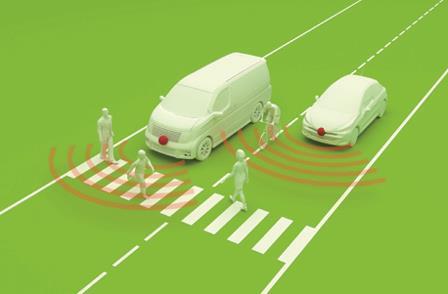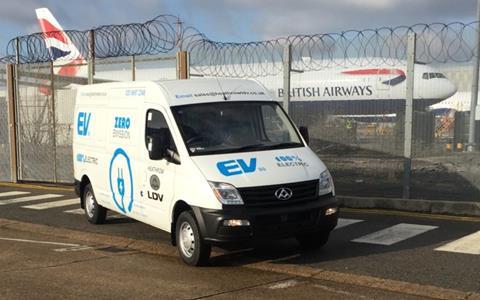
Brigade Electronics’ Quiet Vehicle Sounder was recognised as the innovation of the year at the Motor Transport Awards 2019 for being an elegantly simple solution to warning vulnerable road users of the approach of a quiet vehicle
Brigade Electronics, the Kent firm that pioneered reversing alarms in the UK in 1976, picked up its first ever MT Award this year for its Quiet Vehicle Sounder (QVS), a device to warn blind and partially sighted people as well as other vulnerable road users of the approach of an electric or other quiet vehicle.
Brigade chairman Chris Hanson-Abbott has called the QVS “probably the biggest breakthrough in road safety since the reversing alarm” and has campaigned for over a decade for the mandatory fitment of a QVS to electric vehicles, which he has dubbed “silent killers”.
Our judging panel praised the simplicity of the solution to a relatively new problem. “A small business has taken on a global challenge and produced something that will save numerous lives. It should be congratulated,” said one of our judges.
“Having been in London electric cabs in which the drivers have reported more near-misses, I can definitely see the need,” confirmed another.
After 11 years and more than 50 meetings the UN ratified regulation UNECE R138, specifying the standards for acoustic vehicle alerting systems (AVAS), and from September 2019 all new models of road-going battery electric, hybrid and fuel cell-powered vehicles – including electric cargo bikes – must be fitted with an approved AVAS. All new EVs registered after September 2021 will also have to fit an approved device but Brigade is urging operators already putting quiet vehicles on the roads to retrofit the sounders – which cost under £300 from Brigade – to help prevent collisions with vulnerable road users.
Silent danger
Because such vehicles are nearly silent, pedestrians are often unaware that an EV is approaching or about to pull away. A study by Guide Dogs for the Blind shows that pedestrians are 40% more likely to be struck by an EV than a diesel or petrol vehicle.

Under UNECE R138, the AVAS must start emitting the sound, which is limited to 75dB(A) at a distance of 1m, as soon as the ignition is switched on, though it is disabled when the park brake is applied. The volume of the AVAS automatically increases as the vehicle speeds up but cuts off when the vehicle reaches 20kph by which point tyre and other noise will be an adequate alert to the vehicle’s approach. The pitch of the sound also changes as the EV speeds up and slows down, mimicking an internal combustion engine.
One reason agreement on the standard took so long was the difficulty in finding a sound that was clear enough to be audible in heavy city traffic but would not disturb residents at night. Like Brigade’s smart ‘white sound’ reversing sounders, the QVS uses broadband sound frequencies to ensure it is directional and makes it easy for pedestrians to locate the source.
Hanson-Abbott says: “The sound must be distinctive and command attention but must not startle people or horses. We trialled over 40 different sounds and ended up with our patented QVS. It doesn’t need a lot of decibels because the broadband spectrum means it is impossible to mask the whole sound.”
The legislation requires the fitment of AVAS to all new models of EV from September this year and all new vehicles from September 2021, which means the existing fleet of quiet vehicles and new examples of existing models will not have to be fitted with sounders.
Some larger fleets are looking at retrofitting sounders to their small but growing fleets of EVs but most are just waiting for vehicle OEMs to follow the regulations and start fitting them to future new models.
“The large EV OEMs will develop their own AVAS but we are talking to smaller vehicle manufacturers who don’t have the resource to provide their own product,” says Tony Bowen, Brigade’s LCV and projects manager. “There is a growing number of vehicle convertors who are converting chassis by adding an electric power train. At present, these are typically 7.5-tonne to 12-tonne HGVs. Paneltex, for example, converts some chassis to electric vehicles but they’re quite small numbers.
Aftermarket opportunity
“There is also a great aftermarket opportunity at the moment for retrofitting vehicles. We are doing a trial with one of the UK’s largest parcel delivery companies which has 200 EVs at present. The trial is going well and I am hopeful that we will soon be retrofitting the existing EV fleet and new vehicles when added to the fleet.
“We are also working with one of the UK’s leading building and facilities management companies, which has approximately 100 EVs.
“There are lots of these companies trying to up-spec their current fleets. We’ve got some great opportunities with them in the next 18 months or two years.”
Construction firm Conway has already tried the QVS on one of its electric vehicles, and had good feedback from the driver, according to Bowen.
“He said as soon as it was put on, people would look around. He was driving around little streets in Fulham,” says Bowen. “He said it was a ‘game-changer’ and that as soon as he went out, it was marvellous. Hopefully that feedback gets through to the people who make decisions.
“It’s simple to do a cost-benefit analysis on safety because you look pretty bad if you don’t carry it through,” adds Bowen.
Size matters: Dealing with bigger vehicles
Now that the specification for the AVAS has been laid down, the problem arises of how blind and partially sighted people can distinguish between different sizes of EV. While there are no electric heavy trucks on the UK market yet, the need to decarbonise road freight will inevitably see more large vehicles powered by batteries or hydrogen fuel cells – both of which are virtually silent in operation.

If every EV from a scooter to a bus or truck sounds the same below 20kph, how can a blind person trying to cross a street know how long a vehicle is, once the sounder at the front has passed by?
Hugh Huddy, policy and campaigns manager at the Royal National Institute of Blind People (RNIB), says that as the vast majority of blind and partially sighted people do not have guide dogs, this will become a problem as more larger EVs appear.
“The risk of a blind person crossing the road when the trailer is still passing is a real issue,” he states. “This did not come up in our discussions with the officials drafting the regulations. No one is talking about it. The regulations say the AVAS must be an ‘appropriate sound’ – if the sound is the same for a truck, bus and car then there will be problems.”
With over 100 electric buses already on the streets of London, the issue has been identified by TfL, which has appointed consultants AECOM to come up with a different sound for its red buses.
“The purpose of the regulations was to identify the type as well as the presence of a vehicle,” says Huddy. “London hybrid buses are very quiet. When traffic noise is low, blind people can hear by the heavier tyre noise if it is a bus but it is not easy if the sound is masked by other noise.”
If different sounds to identify longer vehicles cannot be developed within the regulations, one solution could be to fit two or more sounders to buses and trucks.
“Two sounders at either end of a long vehicle would make sense,” says Huddy. “We are talking to TfL about London buses.”
LDV Heathrow adopts QVS for EV80
LDV has been manufacturing and distributing electric vehicles since 2006 and has seen significant sales growth over the last decade.
Half of all vehicles sold at LDV Heathrow are electric, and following the introduction of the new EV80 electric van, LDV Heathrow turned to Brigade’s QVS after being impressed with the product at a Freight in the City exhibition.

Phil Harvey, sales representative at LDV Heathrow, says: “There’s no doubt that the Quiet Vehicle Sounder works.
“We’ve tried over the years to find an appropriate solution that not only does the job but also meets proposed regulations – and there is nothing that can beat the QVS.
“We’ll be installing it on every electric vehicle; there’s no reason it should not be fitted.”











